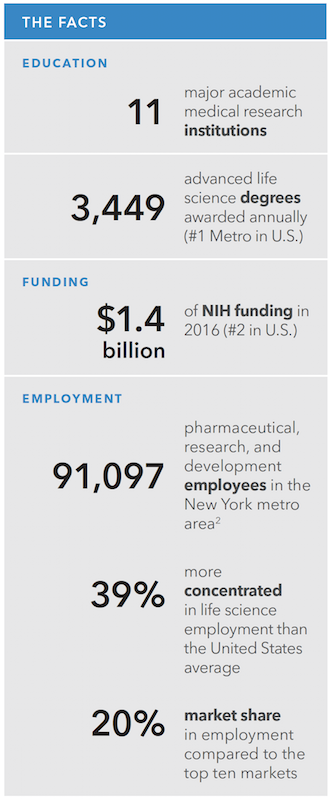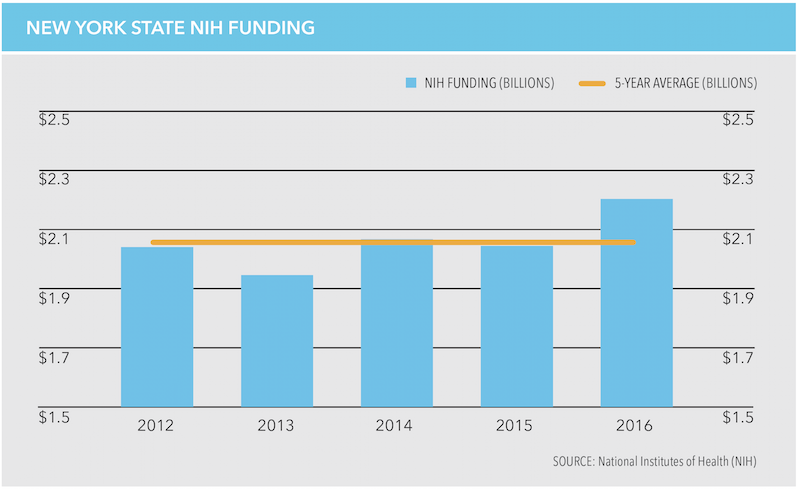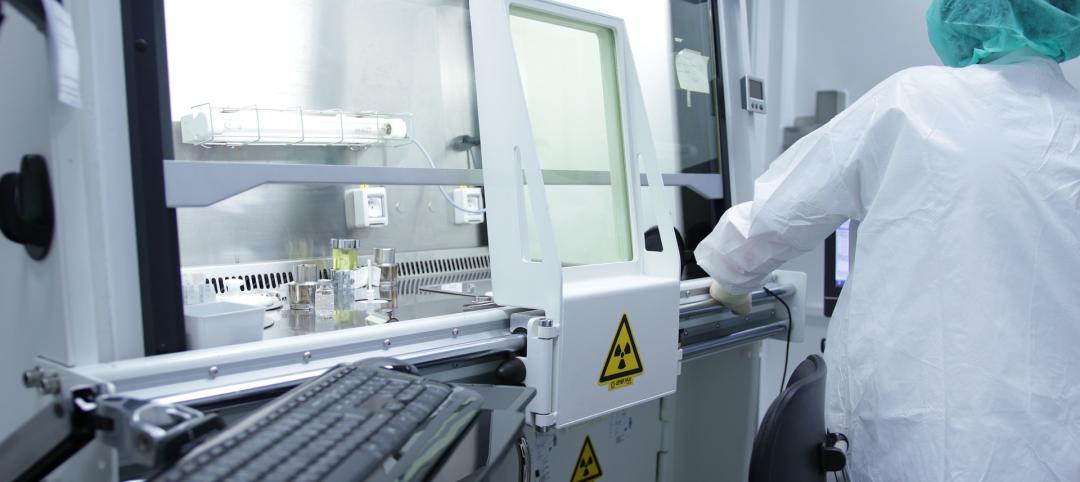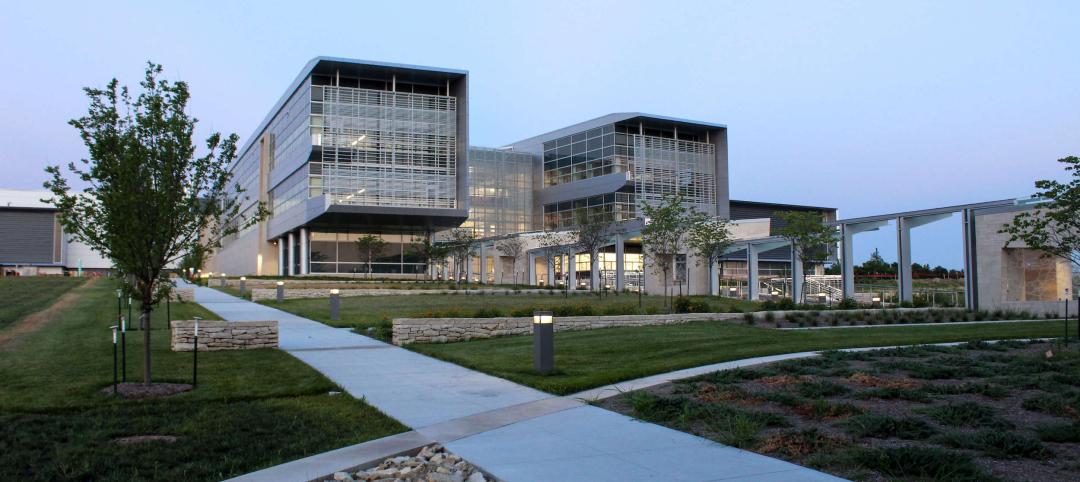Developers Taconic Investment Partners and Silverstein Properties are spending $20 million to renovate the 326,861-sf Movie Lab building in Midtown Manhattan for life science research usage.
The New York Post reports that the Stem Cell Foundation has leased 42,100 sf in this building since 2015. Another 150,000 sf on the top floors of this 10-story building are being upgraded to attract more life science tenants. The building reportedly is changing its name to the Hudson Research Center.
Transwestern, which is marketing this lab space for the developers, has released a special report that portrays New York City as an emerging life sciences hub, where space is tight and development opportunities are multiplying.
New York is already a significant player in this field, by virtue of being home to 11 major academic medical centers, including Weill Cornell Medical College and Albert Einstein College of Medicine. The city also has three of the country’s top 15 hospitals and five of the top 50 medical schools, according to U.S. News and World Report’s latest report card.

New York City is already a leader in life sciences employment and, more recently, available funding. Image: Transwestern
The city also one of the country’s highest concentrations of life-science employees, accounting for one-fifth of the total employment in this sector within the top 10 life science markets.
The problem is shortage of lab space. Transwestern estimates that 100% of the city’s 1.7 million sf of existing life science and research space is occupied. And until recently, New York’s zoning restrictions made it particularly tough for life science companies to build lab space within manufacturing districts—M Zones—that restrict chemical compounding and packaging, the creation of pharmaceutical products and medical appliances, laboratories, research, experimental and testing facilities.
But over the past year or so, market and regulatory changes have made development more conducive for lab science expansion.
Indeed, recent lease transactions have included 49,143 sf at 10 Hudson Yards for Intercept Pharmaceuticals, 30,000 sf at 101 Avenue of the Americas for JLABS (division of J&J Innovations), 19,645 sf at 100 Wall Street for Integra Partners, 11,865 sf at 600 Third Avenue for Turing Pharmaceuticals, and 11,537 sf at 25 West 45th Street for Crossover Health.
More investment capital and funding are flowing into the city for this sector. Out of the $31.3 billion in National Institutes of Health funding awarded nationally in 2016, the New York metro area received $2.7 billion in NIH grants. New York City alone was awarded $1.4 billion, ranking it the second-highest funded city in the country.

More dollars from the National Institutes of Health are flowing into New York State and, particularly, New York City. Image: NIH/Transwestern
Last December, New York Governor Andrew Cuomo unveiled a state-funded life science initiative that includes $250 million in tax incentives for new and existing life science companies, $200 million in state capital grants to further support investment in wet-lab and innovation space, $100 million in investment capital for early stage life science initiatives, and a state match of at least $100 million for operating support from private sector partnerships.
New York City Mayor Bill DiBlasio also has launched a program called LifeSci NYC, which will include a $100 million investment to create a new applied life science campus, $50 million to expand a network of life science R&D facilities, $10 million to expand the network of incubators, $20 million a year in matching funds to support early-stage businesses, and $300 million in tax incentives for commercial lab space.
On the zoning front, in December the Departments of Buildings (DOB) and City Planning (DCP), and the Economic Development Corporation (EDC) issued a clarification memo updating their interpretation of the zoning in the several commercial districts.
The city agencies and the EDC, says Transwestern, “broadened their understanding of the current use group 9A zoning to also include the “synthesis and manipulation of chemical substances, biological matter, and animal models … [that] are integral activities in commercial medical laboratories devoted to research and testing.”
Already, new research and lab spaces are popping up. The Cornell Tech campus on New York City’s Roosevelt Island just opened its first phase. And the 1.17-million-sf Building 77 at the Brooklyn Navy Yard is undergoing a $185 million renovation that could attract lab tenants.
Related Stories
Laboratories | Nov 8, 2023
Boston’s FORUM building to support cutting-edge life sciences research and development
Global real estate companies Lendlease and Ivanhoé Cambridge recently announced the topping-out of FORUM, a nine-story, 350,000-sf life science building in Boston. Located in Boston Landing, a 15-acre mixed-use community, the $545 million project will achieve operational net zero carbon upon completion in 2024.
Laboratories | Sep 20, 2023
Life sciences construction market is poised for a comeback: JLL
The life sciences commercial real estate market has undergone a reset this year but is well positioned to be the comeback kid as capital sources grow more confident and green shoots emerge, according to JLL’s 2023 Life Sciences Industry and Real Estate Perspective.
Laboratories | Aug 24, 2023
Net-zero carbon science center breaks ground in Canada
Designed by Diamond Schmitt, the new Atlantic Science Enterprise Centre (ASEC) will provide federal scientists and partners with state-of-the-art space and equipment to collaborate on research opportunities.
Giants 400 | Aug 22, 2023
Top 115 Architecture Engineering Firms for 2023
Stantec, HDR, Page, HOK, and Arcadis North America top the rankings of the nation's largest architecture engineering (AE) firms for nonresidential building and multifamily housing work, as reported in Building Design+Construction's 2023 Giants 400 Report.
Giants 400 | Aug 22, 2023
2023 Giants 400 Report: Ranking the nation's largest architecture, engineering, and construction firms
A record 552 AEC firms submitted data for BD+C's 2023 Giants 400 Report. The final report includes 137 rankings across 25 building sectors and specialty categories.
Giants 400 | Aug 22, 2023
Top 175 Architecture Firms for 2023
Gensler, HKS, Perkins&Will, Corgan, and Perkins Eastman top the rankings of the nation's largest architecture firms for nonresidential building and multifamily housing work, as reported in Building Design+Construction's 2023 Giants 400 Report.
University Buildings | Aug 7, 2023
Eight-story Vancouver Community College building dedicated to clean energy, electric vehicle education
The Centre for Clean Energy and Automotive Innovation, to be designed by Stantec, will house classrooms, labs, a library and learning center, an Indigenous gathering space, administrative offices, and multiple collaborative learning spaces.
Laboratories | Jul 10, 2023
U.S. Department of Agriculture opens nation’s first biosafety level 4 containment facility for animal disease research
Replacing a seven-decade-old animal disease center, the National Bio and Agro-Defense Facility includes the nation’s first facility with biosafety containment capable of housing large livestock.
Laboratories | Jun 23, 2023
A New Jersey development represents the state’s largest-ever investment in life sciences and medical education
In New Brunswick, N.J., a life sciences development that’s now underway aims to bring together academics and researchers to work, learn, and experiment under one roof. HELIX Health + Life Science Exchange is an innovation district under development on a four-acre downtown site. At $731 million, HELIX, which will be built in three phases, represents New Jersey’s largest-ever investment in life sciences and medical education, according to a press statement.
University Buildings | May 17, 2023
New UC Irvine health sciences building supports aim to become national model for integrative health
The new College of Health Sciences Building and Nursing & Health Sciences Hall at the University of California Irvine supports the institution’s goal of becoming a national model for integrative health. The new 211,660-sf facility houses nursing, medical doctorate, pharmacy, philosophy, and public health programs in a single building.

















